This postcard of Ang Kaew from 1966 might not boast the greenness of Doi Suthep and might not be the stunning scene we’re used to seeing on social media today, but there is more to this faded image than the eye can see. The real value of the postcard lies in the fact that it is an image set in the past, one which many people will have not seen before.
The beauty of Ang Kaew is in its natural setting. However, it is also the handiwork and imagination of those who chose this lovely location for Chiang Mai University, at the foothills of Doi Suthep.
The Chiang Mai University founding committee, led by Professor M.L. Pin Malakul, was determined to build a reservoir on campus as they saw the need for the university to have its own reservoir to produce water. Professor M.L. Pin had given great importance to the planning of Chiang Mai University by not relying on maps alone, but by focusing on exploring the environment himself. That allowed him to see the beauty of the surrounding nature and determine the location that is Ang Kaew today.

Picture of the construction of Ang Kaew

Professor M.L. Pin Malakul visited the construction of Ang Kaew in 1962.
The reason why Ang Kaew was built at the foothills of Doi Suthep is due to the results of the Chiang Mai University area survey at that time. It was found that the location was at the confluence of two creeks from Doi Suthep, Huay Keaw and Huay Ku Khao, perfect for the proposed reservoir. The area was also assessed and approved by two irrigation and engineering experts. The first expert was M.L. Chuchat Kamphu, a former Director-General of the Royal Irrigation Department, who had played an important role in the construction of many important dams in Thailand such as the Bhumibol Dam in Tak Province. The second expert was Professor Aroon Sorathesn, a former rector of Chulalongkorn University. At that time, he was an engineer supervising the construction of buildings in Chiang Mai University, such as the Faculty of Humanities, College Building 1 (the Faculty of Political Science today).

Professor Aroon Sorathesn

M.L. Chuchat Kamphu
Another person who was important to the building of Ang Kaew and the beautiful landscape of Chiang Mai University as a whole was Dr. Paul W. Seagers, Professor of Education and Consultant for School Building Construction at Indiana University. He specialised in the layout of educational institutions in the United States and Europe. Between 1960 - 1963 he became a consultant and advised architects to write plans in preparation for the construction of Chiang Mai University. For this reason, it is not surprising that Chiang Mai University is often named one of the most beautiful universities in Thailand.
The construction of the reservoir began in 1962. After it was finished, the Royal Irrigation Department named it “Huay Kaew Reservoir”, but later Professor M.L. Pin changed the name to “Ang Kaew”. In the same year, the first family to work at Chiang Mai University was the family of Surat Rattanakitkarnkon, an irrigation technician who was transferred to take care of the plumbing works at Ang Kaew to make it ready for use in time for the university's opening in 1964.
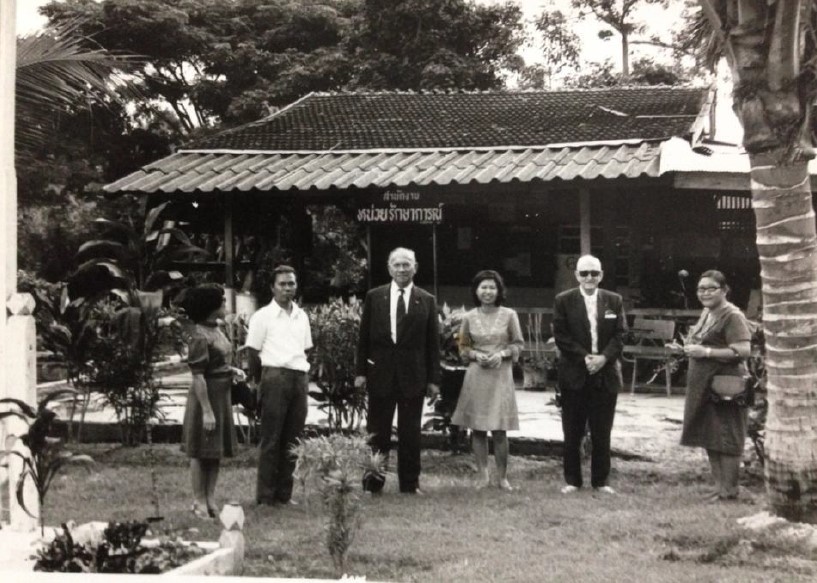
The second from the left, Surat Rattanakitkarnkon, followed by Professor M.L. Pin Malakul.
The next gentlemen are Dr. Paul W. Seagers and Assistant Professor Booneak Fongarpha.
It was noted in the news collection book of Chiang Mai University, No. 5, that:
“In the beginning, Surat had to take care of the work 24/7 as it took hard work to ensure that the dam was well maintained, that the soil held together, that water didn’t wash away the soil, that the surrounding area was green and well cared for, that logs didn’t clog it up, that leaves weren’t littering the reservoir and that water levels remained constant.”
Ridge of Ang Kaew in the past
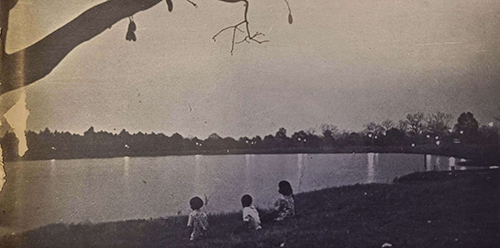
Surat's family lived at the water supply house in front of Ang Kaew. In 1963, “the first baby elephant” (the definition used to refer to Chiang Mai University students) was born in this family. The baby elephant was Surat's daughter named “Tepporn”, who studied and later worked at the university. Tepporn Sukhamwang today holds the title of secretary of the Office of Educational Quality Development of Chiang Mai University.
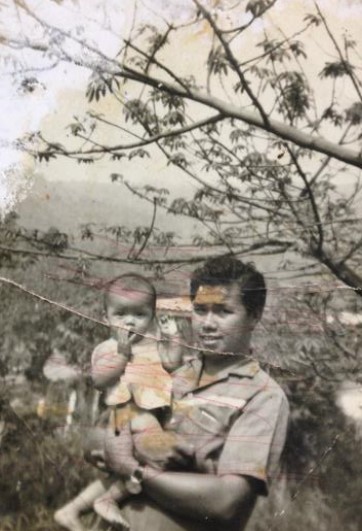
Surat Rattanakitkarnkon and Tepporn, daughter

Picture of Tepporn Sukhamwang in her youth taken at Ang Kaew
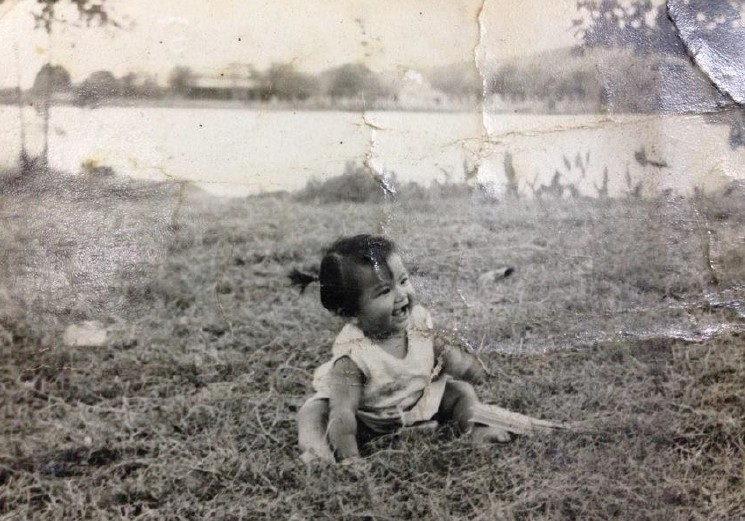
Picture of Tepporn at the floating isle (Koh Khaek) in 1964
On the 50th anniversary of the university, Tepporn told her story and shared pictures of her past, sharing memories of the early years of the university when the area surrounding Ang Kaew was a grove of grass and kapok. Cars used to be allowed on the ridge of Ang Kaew and it was also used as a military helipad on the day of graduation each year. She also reported that Ang Kaew was a dangerous place where many students had unfortunately drowned. As was recorded in Surat Rattanakitkarnkon's family history, he had a deep love and bond with the university and had worked with the determination that “he would do everything to honour and repay the land that served us all,” until his death as director of the Welfare Division in 1995.
Nowadays, Ang Kaew is almost 60 years old, but the surrounding landscape is much more beautiful than its early days. The area has been landscaped and is spectacular to look at. The fertile ecosystems of the riverside forests at the foot of the hills around Ang Kaew have been well preserved, including big and small trees. Today, animals such as turtles, insects and birds, especially the around 2,000 parrots that fly to live on the little isle in the middle of the reservoir in July and August of every year can be found in this area - a good indicator of the abundance of the reservoir’s ecosystem.
The little isle in the middle of the reservoir where parrots fly to live every year
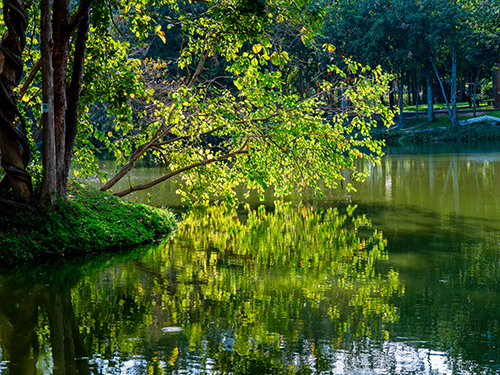
The abundance of trees and ecosystems around Ang Kaew
The Floating Isle or Koh Khaek, the area to the left of the reservoir that extends out into the water, has recently been renovated and given a new lease on life, with benches and walkways dotted around the isle. The origin of the name Koh Khaek comes from rumours of an incident where a Muslim student drowned. There is a stone inscription in front of the entrance that says Karn Memorial Park 25th Anniversary. A Thai Indian, who did not wish to be named, sponsored the renovation of Koh Khaek during the time when Professor Dr. Kasem Wattanachai was the President and Assistant Professor Nipon Tuwanon, the Vice President.
Koh Khaek extending out into the water
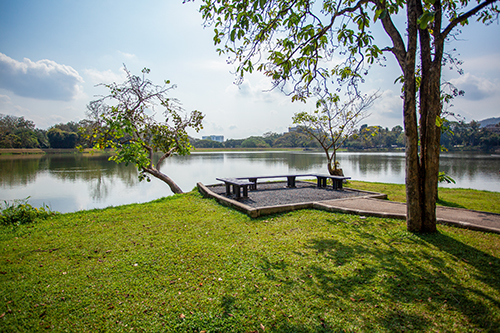
The isle area has been beautifully landscaped
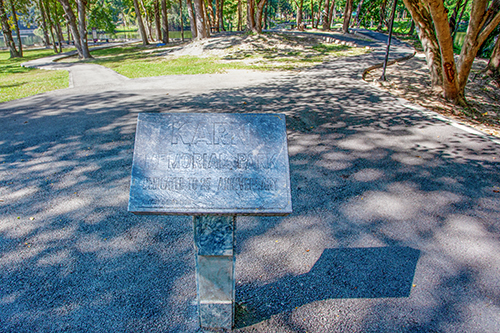
A stone plaque on Koh Khaek
The renovation of Koh Khaek was the spark that led to further development of the area.
Clinical Professor Niwes Nantachit, President of Chiang Mai University started to adjust the landscape around the reservoir, building a walkway, lighting it up at night and building a bridge connecting Ang Kaew and Ang Kaew village, transforming it to a walking and running circular path connected to Ang Tad Chompoo, solving the problem of cluttered areas that could cause security issues. This change has transformed Ang Kaew into a public park on the edge of the mountain that is bustling with visitors, both as a place for exercise and a place to rest the mind. Maybe because the beauty of Ang Kaew is imprinted in the hearts of people who never get tired of visiting, it is a place of many memories.
From past to present, Doi Suthep continues to embrace the university, sending its water downstream to be collected at Ang Kaew. Over time it has been the same hills, the same creeks, the same streams which have flowed like a ‘gift of time’, passed down from generation to generation. The pioneers of Chiang Mai University transformed a wasteland into a beauty beyond imagination and one which is treasured by all graduating classes through the decades.
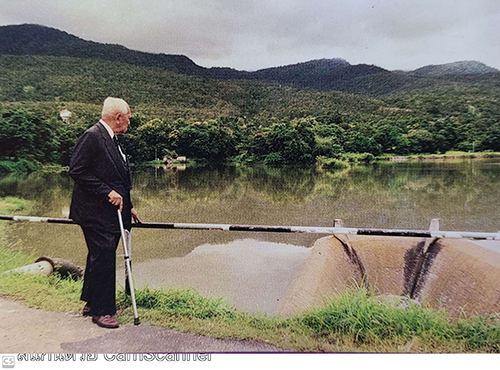 Professor M.L. Pin Malakul visited Ang Kaew during his final days.
Professor M.L. Pin Malakul visited Ang Kaew during his final days.